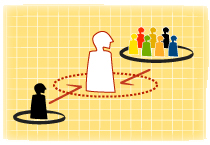Man derives his identity from both the world outside and the world inside him.
He therefore has a profound choice.
This choice is not trivial, and is at the heart of the search for a global identity for global citizens.
All forms of membership identities – national, local, community-level, religious, social, racial, professional, cultural – are outside-in dimensions of our personal identity.
Such outside-in dimensions of our personal identities are by definition narrow, divisive, and deeply colored by our frames of thinking/ mental models, practices/rituals, norms/ protocols and structures of interaction defined by the outside group from whom I derive my identity.
On the other hand, the dimensions of a personal identity based on one’s inherent human competencies and attributes – the capacity to think, to love, to act, to create, to find solutions to challenges, to engage deeply, to contribute unselfishly, are derived from my own inner sense of self. These inside-out dimensions of our identities are inherently freedom-giving, universalizing, and transcending of divisions.
This leads us to a paradox in the search for a global identity for a global citizen. The paradox is this: we do not find the global identity we seek by laboriously opening up and “widening” each of the many outside-in dimensions of the personal identities that we function in.
Instead we develop a global identity by turning ‘in’ and finding, strengthening and expressing the inside-out and universal dimensions of our everyday identities.
Yet we need to nurture both the outside-in and inside-out dimensions of our personal identity to function simultaneously, responsibly and effectively, both in the local context and in the global society.
We must therefore resolve this paradox between inside-out and outside-in identities.
This is accomplished when we develop a new vision of personal identity which I call “enabling identities”.
Enabling identities are constructs that seek to modify or transform neither the human (inside-out) dimensions, nor the societal (outside-in) dimensions of human identity.
Instead they offer a new space for cultural architecture. This new space lies in the “modes of engagement” between man and society.
One example of an identity rooted neither in the individual nor in the community, yet affirming both, is the “contributor identity”. Contribution is a mode of engagement that allows an individual to freely choose to give to society and thereby find fulfillment within and meet his responsibilities outside.
Such an identity is both global/universal, and local/communitized in its manifestation.
Such an enabling identity is the “design-space” in which we begin architecting global identities for global citizens.

